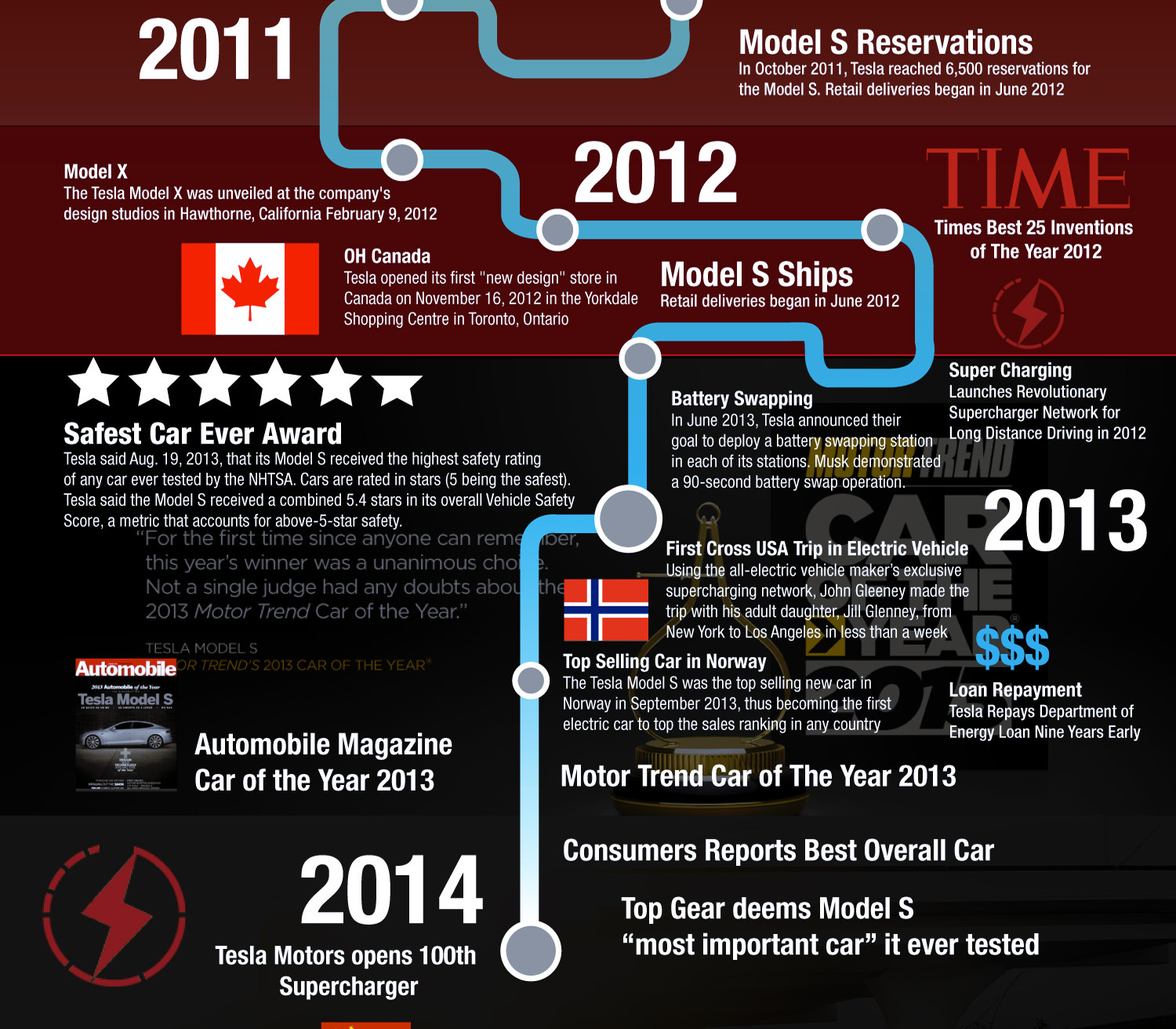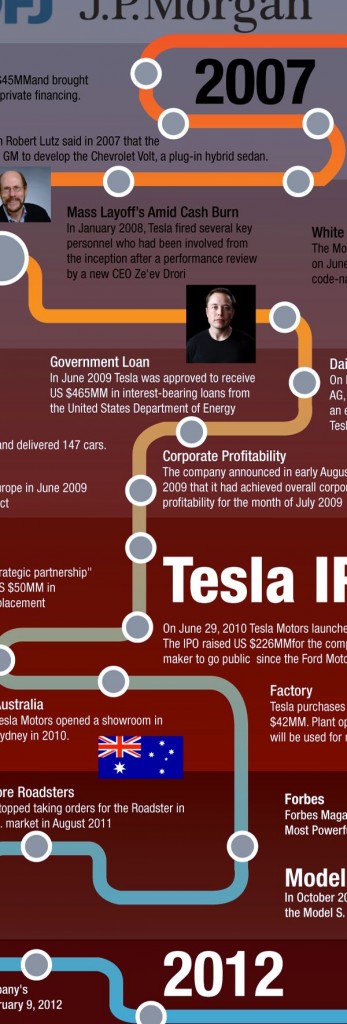News
Teslaccessories prize infographic shows Tesla Motors tremendous growth

It’s difficult to refer to Tesla Motors as the small Californian startup these days. In a few years, the company has grown exponentially, challenging more industries than the biggest startup success stories in decades. An infographic from EVannex shows us Tesla’s progression in the midst of an automotive industry caught daydreaming, an energy sector happy with business as usual, and other far reaching consequences for many unsuspecting industries.
Where were you when you came on-board?
Matthew Pressman at EVannex asks this simple question, when did you come on-board the Tesla’s meteorite ascension to success? Was it in 2003 when Elon Musk and Martin Eberhard thought how cool a little electric performance car would be, or when the Roadster was publicly displayed in 2007? How about when the battery swapping event was held last year, putting to shame the amount of time it took an Audi sedan to fill its gasoline tank, or is it this week as the company celebrates its 100th Supercharger?
I came on-board when Chelsea Sexton was showing Elon Musk’s Roadster in 2007. However, I missed the opportunity to buy one and bitterly regret it to this day. I’ve always loved performance, but two things she said would forever change my life. She told me she changed the tires on her EV1 every 5,000 miles and that no BMW could keep up with her at a red light. Being an avid Alfa Romeo fan, those words resonated far within. I was intrigued and my suspicions were confirmed the day I drove an AC Propulsion eBox and finally, the crème de la crème, my friend’s Tesla Roadster. I was hooked instantaneously. The electric motor made 100% sense in a car or motorcycle. In fact, I was sad getting back into my beloved Alfa Romeo Spider, feeling the harsh limitations of engines and gearboxes matching.
I’ve written about Tesla ever since, watching its every move, trying to figure out the consequences for many industries caught in bottom line profits and courting Wall Street investors with short sight visions. Since then, Tesla has shown it has the right vision. Musk has surrounded himself with the right people and the company today shows how most company be run, with far reaching vision and not simply bottom line profits as their number one preoccupation.
EVannex, Tesla accessories and the prize
Who is EVannex? EVannex offers a great line of accessories for your Tesla lifestyle. Ranging from elegant center console inserts, to redesigned cupholders, to wheels and more, the company offers great complements to an already great car. The company stands out in many ways, as it offers very nice additions without going overboard into bling-bling land. Often times, tuners and accessory makers cross the fine line between enhancing and completely losing the original feel of the car. EVannex doesn’t. They keep the Tesla Model S’ feel and add a touch of je ne sais quoi.
Evanex, the folks behind this cool infographic are throwing in a contest I invite you to join. Find out more on their Facebook page.
You can tag yourself on the time line, showing when you bought your first Tesla. This will give you a chance to win an EVannex prize pack, either a Driving the Future Sculpture or the Owning Model S Book.

Elon Musk
Elon Musk and Tesla AI Director share insights after empty driver seat Robotaxi rides
The executives’ unoccupied tests hint at the rapid progress of Tesla’s unsupervised Robotaxi efforts.

Tesla CEO Elon Musk and AI Director Ashok Elluswamy celebrated Christmas Eve by sharing personal experiences with Robotaxi vehicles that had no safety monitor or occupant in the driver’s seat. Musk described the system’s “perfect driving” around Austin, while Elluswamy posted video from the back seat, calling it “an amazing experience.”
The executives’ unoccupied tests hint at the rapid progress of Tesla’s unsupervised Robotaxi efforts.
Elon and Ashok’s firsthand Robotaxi insights
Prior to Musk and the Tesla AI Director’s posts, sightings of unmanned Teslas navigating public roads were widely shared on social media. One such vehicle was spotted in Austin, Texas, which Elon Musk acknowleged by stating that “Testing is underway with no occupants in the car.”
Based on his Christmas Eve post, Musk seemed to have tested an unmanned Tesla himself. “A Tesla with no safety monitor in the car and me sitting in the passenger seat took me all around Austin on Sunday with perfect driving,” Musk wrote in his post.
Elluswamy responded with a 2-minute video showing himself in the rear of an unmanned Tesla. The video featured the vehicle’s empty front seats, as well as its smooth handling through real-world traffic. He captioned his video with the words, “It’s an amazing experience!”
Towards Unsupervised operations
During an xAI Hackathon earlier this month, Elon Musk mentioned that Tesla owed be removing Safety Monitors from its Robotaxis in Austin in just three weeks. “Unsupervised is pretty much solved at this point. So there will be Tesla Robotaxis operating in Austin with no one in them. Not even anyone in the passenger seat in about three weeks,” he said. Musk echoed similar estimates at the 2025 Annual Shareholder Meeting and the Q3 2025 earnings call.
Considering the insights that were posted Musk and Elluswamy, it does appear that Tesla is working hard towards operating its Robotaxis with no safety monitors. This is quite impressive considering that the service was launched just earlier this year.
Elon Musk
Starlink passes 9 million active customers just weeks after hitting 8 million
The milestone highlights the accelerating growth of Starlink, which has now been adding over 20,000 new users per day.

SpaceX’s Starlink satellite internet service has continued its rapid global expansion, surpassing 9 million active customers just weeks after crossing the 8 million mark.
The milestone highlights the accelerating growth of Starlink, which has now been adding over 20,000 new users per day.
9 million customers
In a post on X, SpaceX stated that Starlink now serves over 9 million active users across 155 countries, territories, and markets. The company reached 8 million customers in early November, meaning it added roughly 1 million subscribers in under seven weeks, or about 21,275 new users on average per day.
“Starlink is connecting more than 9M active customers with high-speed internet across 155 countries, territories, and many other markets,” Starlink wrote in a post on its official X account. SpaceX President Gwynne Shotwell also celebrated the milestone on X. “A huge thank you to all of our customers and congrats to the Starlink team for such an incredible product,” she wrote.
That growth rate reflects both rising demand for broadband in underserved regions and Starlink’s expanding satellite constellation, which now includes more than 9,000 low-Earth-orbit satellites designed to deliver high-speed, low-latency internet worldwide.
Starlink’s momentum
Starlink’s momentum has been building up. SpaceX reported 4.6 million Starlink customers in December 2024, followed by 7 million by August 2025, and 8 million customers in November. Independent data also suggests Starlink usage is rising sharply, with Cloudflare reporting that global web traffic from Starlink users more than doubled in 2025, as noted in an Insider report.
Starlink’s momentum is increasingly tied to SpaceX’s broader financial outlook. Elon Musk has said the satellite network is “by far” the company’s largest revenue driver, and reports suggest SpaceX may be positioning itself for an initial public offering as soon as next year, with valuations estimated as high as $1.5 trillion. Musk has also suggested in the past that Starlink could have its own IPO in the future.
News
NVIDIA Director of Robotics: Tesla FSD v14 is the first AI to pass the “Physical Turing Test”
After testing FSD v14, Fan stated that his experience with FSD felt magical at first, but it soon started to feel like a routine.

NVIDIA Director of Robotics Jim Fan has praised Tesla’s Full Self-Driving (Supervised) v14 as the first AI to pass what he described as a “Physical Turing Test.”
After testing FSD v14, Fan stated that his experience with FSD felt magical at first, but it soon started to feel like a routine. And just like smartphones today, removing it now would “actively hurt.”
Jim Fan’s hands-on FSD v14 impressions
Fan, a leading researcher in embodied AI who is currently solving Physical AI at NVIDIA and spearheading the company’s Project GR00T initiative, noted that he actually was late to the Tesla game. He was, however, one of the first to try out FSD v14.
“I was very late to own a Tesla but among the earliest to try out FSD v14. It’s perhaps the first time I experience an AI that passes the Physical Turing Test: after a long day at work, you press a button, lay back, and couldn’t tell if a neural net or a human drove you home,” Fan wrote in a post on X.
Fan added: “Despite knowing exactly how robot learning works, I still find it magical watching the steering wheel turn by itself. First it feels surreal, next it becomes routine. Then, like the smartphone, taking it away actively hurts. This is how humanity gets rewired and glued to god-like technologies.”
The Physical Turing Test
The original Turing Test was conceived by Alan Turing in 1950, and it was aimed at determining if a machine could exhibit behavior that is equivalent to or indistinguishable from a human. By focusing on text-based conversations, the original Turing Test set a high bar for natural language processing and machine learning.
This test has been passed by today’s large language models. However, the capability to converse in a humanlike manner is a completely different challenge from performing real-world problem-solving or physical interactions. Thus, Fan introduced the Physical Turing Test, which challenges AI systems to demonstrate intelligence through physical actions.
Based on Fan’s comments, Tesla has demonstrated these intelligent physical actions with FSD v14. Elon Musk agreed with the NVIDIA executive, stating in a post on X that with FSD v14, “you can sense the sentience maturing.” Musk also praised Tesla AI, calling it the best “real-world AI” today.









